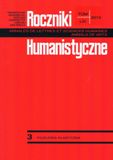Elementy mimu w epodzie Horacego „Quid tibi vis, mulier”
Elements of the Mime in Horace’s Epode “Quid tibi vis, mulier”
Author(s): Wojciech KopekSubject(s): Language and Literature Studies
Published by: Towarzystwo Naukowe KUL & Katolicki Uniwersytet Lubelski Jana Pawła II
Keywords: Horace; Herondas; mime; epode; parody; iuvenis; mulier; (literary) context
Summary/Abstract: This article aims at discovering the literary context for Horace’s Epode 12 through juxtaposing it against Herondas’ mimes; in particular against Mime V, entitled Jealous. The description of the relationship that obtains between these works relies on the ancient theory of rhetoric and on elements of Ars poetica by Horace. The research helped determine that Epode 12 reveals numerous features that are characteristic of the mime: it is an apparent dialogue (sermocinatio) recited by a single performer (mime), most probably in a scenery of an ancient feast. A participant of the feast becomes an actor, who first performs the role of a male lover (iuvenis), and then he plays an elderly female lover (mulier). These protagonists are typical of old and new comedy styles. Nevertheless, the whole dramatic setting seems to bear the semblance of Mime V, in which the same literary protagonists can be found in the scene of a row between lovers. Specific rhetorical figures (imitatio) indicate, on the one hand, that the literary original was used in a creative manner. On the other, Mime V can also be used in the interpretation of Epode 12. This interpretation can be built on the processes of liberation and subjugation as part of the lovers’ relationship (actual subjugation in Mime V, and metaphorical—financial in Epode 12, where iuvenis is mulier’s “kept man”).
Journal: Roczniki Humanistyczne
- Issue Year: 61/2013
- Issue No: 03
- Page Range: 5-20
- Page Count: 16
- Language: Polish

